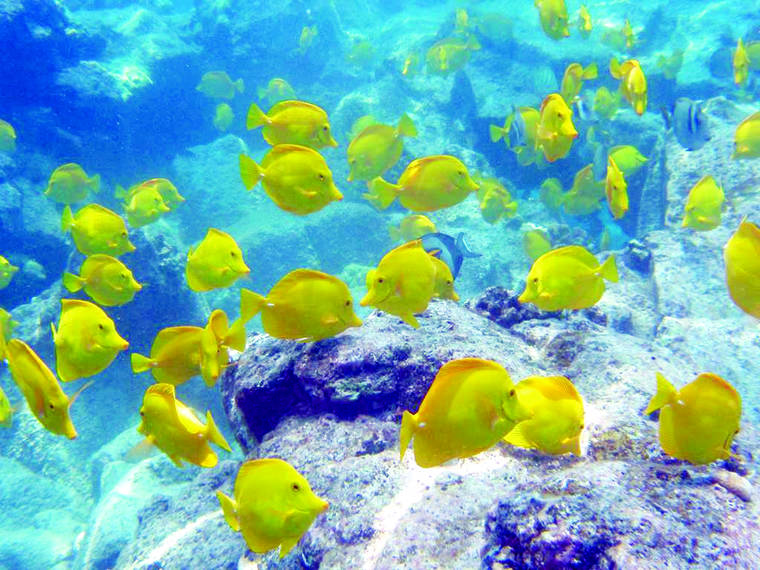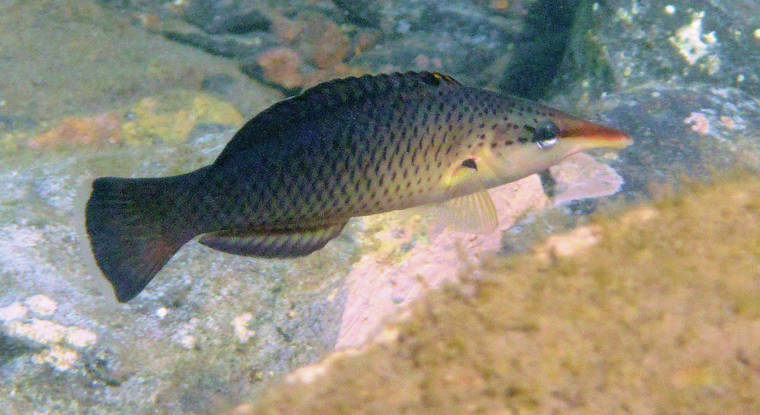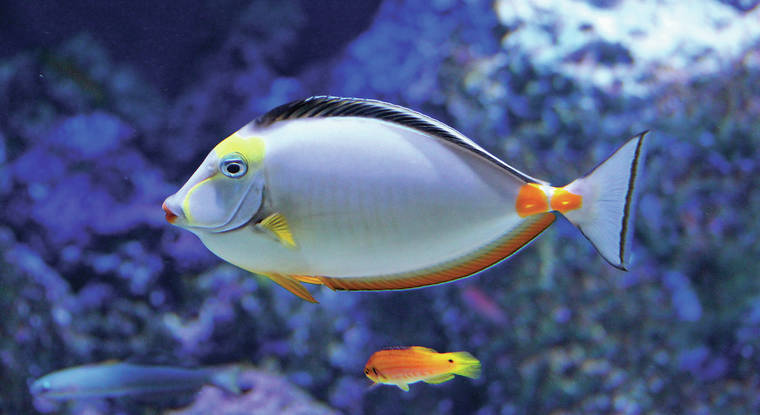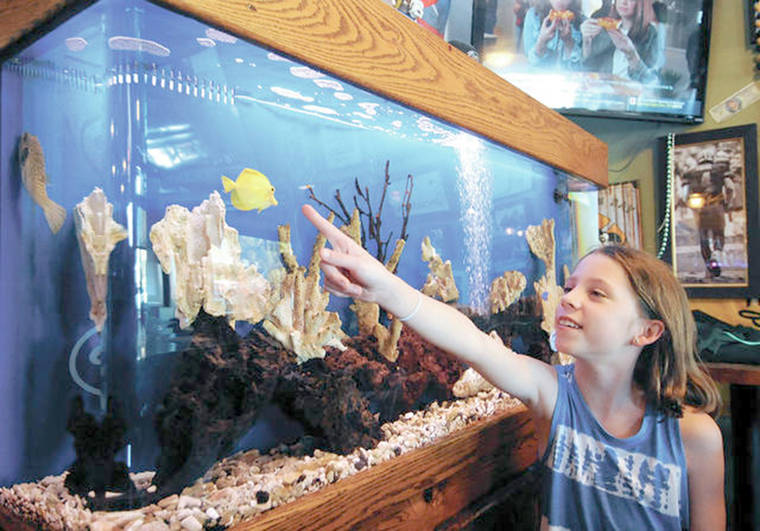Aquarium trade reveals revised EIS for West Hawaii fishing

This undated file photo from Oregon State University shows a school of yellow tang off the coast of Hawaii Island. The state says it is taking immediate steps to comply with a court order shutting a loophole that allowed for continued commercial aquarium fish collection despite a 2017 high court ruling that halted the practice pending environmental review. (AP Photo/Oregon State University, Bill Walsh,File)

Under the updated proposal, only yellow tang (pictured), kole, orangespine unicornfish, potter’s angelfish, brown surgeonfish, thompson’s surgeonfish, black surgeonfish and bird wrasse would be allowed to be caught. (Pixabay/Special to West Hawaii Today)

Under the updated proposal, only yellow tang, kole (pictured), orangespine unicornfish, potter’s angelfish, brown surgeonfish, thompson’s surgeonfish, black surgeonfish and bird wrasse would be allowed to be caught. (Pixabay/Special to West Hawaii Today)

Under the updated proposal, only yellow tang, kole, orangespine unicornfish, potter’s angelfish, brown surgeonfish, Thompson’s surgeonfish, black surgeonfish and bird wrasse (pictured) would be allowed to be caught. (Pixabay/Special to West Hawaii Today)

Under the updated proposal, only yellow tang, kole, orangespine unicornfish (pictured), potter’s angelfish, brown surgeonfish, Thompson’s surgeonfish, black surgeonfish and bird wrasse would be allowed to be caught. (Pixabay/Special to West Hawaii Today)

Proposed annual quotas for each of the eight species on a new Revised White List are put forth in PIJAC’s revised EIS. (Special to West Hawaii Today)

Above: A child points to a yellow tang in a fish tank at Quinn’s aquarium in this 2019 file photo. Left: A kole, one of the fish that would be allowed to be caught. (Laura Ruminski/West Hawaii Today)
The Pet Industry Joint Advisory Council has released a revised draft environmental impact statement with a new proposal to reopen West Hawaii’s coastal waters to commercial aquarium fishing.
The Pet Industry Joint Advisory Council has released a revised draft environmental impact statement with a new proposal to reopen West Hawaii’s coastal waters to commercial aquarium fishing.
The move comes nine months after the state Board of Land and Natural Resources unanimously rejected the group’s first environmental impact statement (EIS).
The council’s updated proposal includes reducing the number of aquarium fishing permits issued in the West Hawaii Regional Fishery Management Area (WHRFMA) from 10 to seven and creates a “Revised White List” consisting of eight species. The WHRFMA spans the entire coastline of West Hawaii, from Upolu Point in North Kohala to Ka Lae (South Point) in Ka‘u.
Only yellow tang, kole, orangespine unicornfish, potter’s angelfish, brown surgeonfish, Thompson’s surgeonfish, black surgeonfish and bird wrasse would be allowed to be caught. Further, each of the seven permitted fishers would be limited to annual catch quotas of 1% of the estimated WHRFMA Open Area population for each species, per the document published Tuesday by the state Office of Environmental Quality Control kicking off a 45-day public comment period.
Interestingly, despite the reduction in permits and proposed annual quotas, the revised EIS estimates an increased impact of collection for each of the eight species compared to the previous EIS released in April 2020. For example, the estimated yellow tang collection increases to 3.3% of the population based on NOAA’s Pacific Islands Fisheries Science Center Ecosystem Sciences Division (formerly Coral Reef Ecosystems Program) estimates, compared to a maximum estimate of just 1.93% of the population in last year’s EIS.
The Pet Industry Joint Advisory Council (PIJAC) makes three primary environmental claims in its revised EIS justifying their new proposal.
• First: the proposed annual quota would cap the total take to “7.0% of any species’ WHAP (West Hawaii Aquarium Project) Open Area population estimates.”
• Second: “Research suggests collection of between 5%-25% is sustainable for various reef species similar to those on the White List.”
• Third: “Two studies have concluded that the aquarium fishery has no significant impact on coral or the reef ecosystem.”
These claims, however, appear to be built upon strikingly similar data and evidence from the previous EIS already rejected by the Board of Land and Natural Resources (BLNR), and have been explicitly disputed by a group consisting of Gregory P. Asner, Shawna A. Foo, Roberta E. Martin and Rachel R. Carlson from the ASU Center for Global Discovery and Conservation Science in Hilo.
“We believe that the FEIS has not adequately covered the relevant topics … blatantly ignoring public comments including our professional review dated 3 January 2020, and omitting key facts and data required for an objective review of the impacts of aquarium fish collection,” the center said in an analysis. “The decision to allow aquarium collection is not a contest of the most discontented, but should be based on sound science, which is lacking in the FEIS.”
In particular, the second claim comes from a source — Ochavillo and Hodgson (2006) — cited often in both in the original and revised EIS. This source was questioned as reason for nonacceptance by the BLNR in its initial rejection in May 2020, when they stated the original EIS “has an inadequate justification for the reliance on this publication as the best available science.”
Rene Umberger, executive director of For the Fishes, said the updated proposal feels more like a negotiation attempt than an effort to conduct a proper EIS.
“That’s not how Hawaii’s environmental law works. You need to describe the impacts and propose mitigation, especially in a conservation district,” Umberger said. “We’re not negotiating here; we’re just asking them to adhere to the requirements for an environmental impact statement.”
Another group consisting of For the Fishes, Kalanihale, Moana Ohana, Center for Biological Diversity, Kai Palaoa and the Humane Society of the United States expressed concern for the process in which the EIS has been completed.
“First and foremost is our expectation that the erroneous methods, characterizations, and conclusions, which dominated the previous process, are replaced with those that are accurate and appropriate,” the group said in its response to become a consulted party.
When asked if these expectations had been met in the revised EIS, Umberger was frank.
“Absolutely not,” she said. “They’re using the same playbook.”
According to the first draft EIS, the Hawaii commercial aquarium fishery reported landings greater than $2.2 million in 2017. Hawaii Island reported landings near $1.4 million with more than $1.29 million in the West Hawaii Regional Fishery Management Area alone. The WHRFMA has been closed since a September 2017 Hawaii Supreme Court ruling that the issuance of commercial aquarium collection permits under HRS 188-31 required Hawaii Environmental Policy Act review.
The revised EIS is currently subject to a 45-day public review and comment period; comments are due by April 9. PIJAC will then take those comments and submit a final revised EIS to the BLNR for approval or nonapproval.
To find the environmental document, check out the latest edition of The Environmental Notice put out by the Office of Environmental Quality Control at http://oeqc2.doh.hawaii.gov/The_Environmental_Notice/2021-02-23-TEN.pdf.


